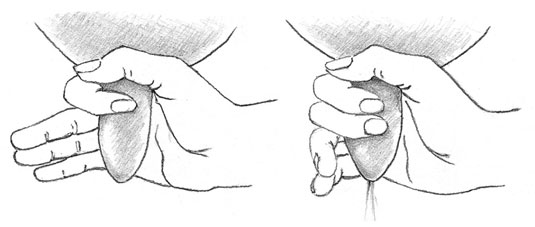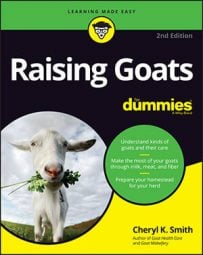Never pull on the teat. This is not how milk is extracted, and it can cause injury to the mammary system.

-
Milk stand: Although people milk their goats in every situation imaginable, investing in a milk stand will make milking easier.
-
Stainless steel bucket: Start with a six-quart bucket unless you're milking Nigerian Dwarves or Pygmies, which require a smaller one because they're shorter.
-
Udder-washing supplies: You can use an old plastic coffee can with hot water and dish soap, rags made from towels cut into smaller pieces, and paper towels for drying. You need to wash the container after every milking and rinse with boiling water or a bleach solution (one part bleach to ten parts water).
-
Teat sanitizing supplies: You need teat dip and cups or spray teat sanitizer, which you can purchase from a dairy supply company or feed store.
-
Stainless steel strainer and milk filters: You can buy strainers and filters from a dairy supply company or feed store.
-
Jars for milk storage: Half-gallon mason jars with plastic lids work great, because the plastic doesn't rust when it gets wet.
-
Get the goat onto the milk stand and secure her in the stanchion with some grain for her to eat.
-
Wash your hands.
-
Clean the udder and teats with warm water and soap or sanitize with a wipe such as Milk Check Teat Wipes and dry them with a clean paper towel.
Make sure to thoroughly dry your hands.
-
Wrap your fingers and thumb around each teat to trap some milk in the teat and squeeze to quickly milk one or two squirts from each teat into a cup.
This step allows you to check for abnormalities and removes any milk close to the surface of the teat that is more likely to be contaminated with bacteria. If the milk is abnormal, dispose of it after milking.
-
Promptly milk the goat using a sanitized bucket, being careful not to pull on the teats.
If you take too long to milk, the goat may start dancing or causing other mischief.
-
When you think the udder is empty, massage the back and bottom of the udder and bump it gently with your fist in the front near the teats to encourage further let-down.
-
Pour the milk through a clean, filtered strainer into a clean jar.
-
Dip or spray the teats with a sanitizer such as Derma Sept Teat Dip.
If you use dip cups, use a clean one for each goat to avoid cross-contamination.
-
Return the goat to the herd.
Have some fresh hay or alfalfa and fresh water available for the goat right after milking. She will eat and drink, instead of lying down and exposing an open teat orifice to bacteria.
-
Clean the bucket and strainer and air dry.
Rinse the bucket and strainer with tepid water right away. Wash with warm soapy water and rinse with boiling water or a solution of one part bleach to ten parts water.
To practice milking without fear of injuring the goat, use a rubber glove filled with water and tied shut at the top. This will give you an idea of how closing the teat (finger) off from the udder (hand) traps the water in the finger, allowing you to capture the liquid by squeezing the teat.

